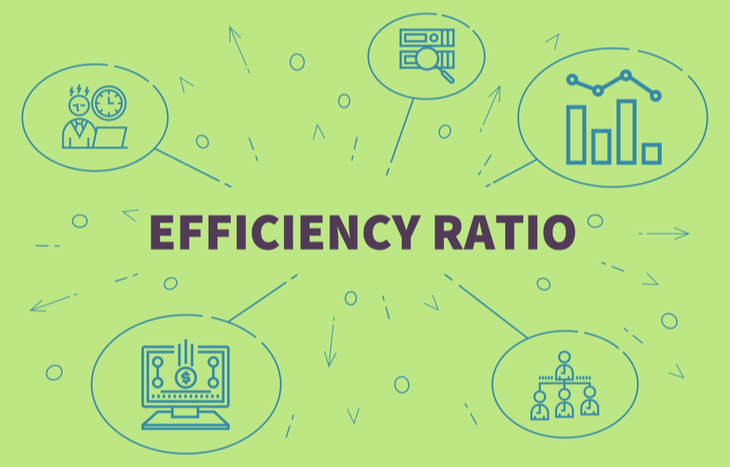Efficiency Ratio: What It Is And How To Use It
As of 2021, the New York Stock Exchange had approximately 2,500 listed companies. The fully-digital NASDAQ had over 3,700. With so many publicly-traded companies out there, investors need a quick, uniform way to evaluate each business. To do this, they turn to the efficiency ratio. Let’s examine what an efficiency ratio is and how you can leverage it to your advantage.

What’s an Efficiency Ratio?
An efficiency ratio, also called an activity ratio, is any metric that tells a company how well it uses its resources to make a profit. Efficiency ratios are like the chapter titles in a book. They don’t tell you the full story. But, reading through them will still give you a good idea of what the story is about. Efficiency ratios use a company’s assets and liabilities to quantify the operations of the business.
The first thing to note is that there are many different types of efficiency ratios. For example, a few of the most common ratios are:
- Operating margin: Measures how much profit a company makes per dollar of sales after variable expenses but before interest and tax expenses. Divide operating earnings by revenue.
- Price-to-earnings: Shows how much investors are willing to pay per share for $1 of earnings. This ratio can determine if a company is over or undervalued. Divide the stock share price by earnings per share.
- Return-on-assets: Measures how efficiently a company uses its assets to generate a profit. Divide the company’s net income by its average assets.
- Return-on-equity: Measures how efficiently a company generates a profit from its equity financing. Divide the company’s net income by its shareholder equity.
- Inventory turnover: Measures how quickly inventory is sold, replaced or used. Divide the cost of goods by the average inventory for the same period.
- Cash conversion: Measures how efficiently a business converts its sales and income into cash. Divide the cash flow from operations by net income.
- Debt-to-equity: Measures how much leverage a company is using. In other words, how much shareholder equity is available to cover the company’s outstanding debts. Divide total liabilities by shareholder equity.
As you can see, each of these efficiency ratios measures a different aspect of the business’s operations. However, let’s take a closer look at what all this information means.
How Do Companies Use This Information?
Business managers use efficiency ratios to get a snapshot of how their business is performing over a given period. These ratios also tell managers how well they are performing their job (operating the business). Managers can use these metrics to measure themselves, their competition, and industry standards.
Managers can use efficiency ratios to see where the business excels. But, even more importantly, managers can see what improvements may help. Efficiency ratios are a little bit like a scorecard for the business. They tell the manager how the business grades in different areas. From there, it’s up to the manager to determine why a certain grade is poor and the best way to improve it.
Cash Conversion Example
Let’s say that you are the CFO of a company. You generate a report of the company’s operations. In this report, you notice that your company’s cash-flow conversion ratio is low (a perfectly efficient ratio is 1). This tells you that your company is struggling to convert profits and sales into actual cash. If this low conversion rate continues then your business could have a potential liquidity problem. In other words, despite having good sales your company is at risk of running out of cash to pay its expenses. If your company has a large unexpected expense then it could become insolvent.
Once you have this information, you can devise a plan to improve the company’s cash conversion. And there are a few ways to do this. Start by establishing a corporate policy of net-15 payment terms. You can also give customers more payment options or change your invoicing software.
This is just one example of how companies leverage an efficiency ratio. But what if you’re not the CFO of a company. Why should you, as an investor, care about these metrics?
How Can You Use This Information?
As the investor, you can also leverage this information to make decisions. The difference is that you weren’t hired to fix the company’s problems. Instead, you want to determine whether or not you should invest in the business.
Efficiency ratios are interesting metrics because they are both simple and complex at the same time. The ratio itself is fairly simple. However, understanding the context of the ratio is where it can get more complex. In other words, an efficiency ratio will tell you what is good or bad within a company. But, it doesn’t tell you why. You’ll need to figure this out for yourself.
In fact, you can use efficiency ratios to evaluate stocks. Each efficiency ratio will give you a small glimpse into the company as a whole. However, it’s up to you as the investor to evaluate these metrics. Assess the bigger picture and determine whether or not to invest.
I hope you’ve enjoyed learning about how to use an efficiency ratio! Please remember that I’m not a financial advisor and just offer my own research and commentary. As usual, please base all investment decisions on your own due diligence.





